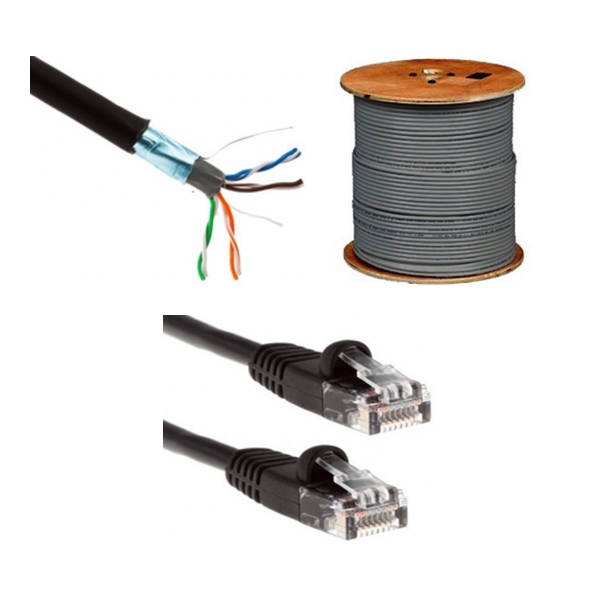Ethernet Cable

Ethernet cables are a critical component of wired data networks, providing reliable, high-speed communication between devices such as computers, routers, switches, and security systems. Common categories include CAT5e, CAT6, CAT6A, and CAT8 Ethernet cables, each designed to support specific data rates, bandwidth requirements, and transmission distances in residential, commercial, and industrial environments.
Most Ethernet cables are constructed using twisted pair wire, where insulated copper conductors are twisted together to reduce electromagnetic interference and signal crosstalk. CAT5e and CAT6 cables typically contain four twisted pairs, making them well suited for standard networking applications in homes and offices. Higher-performance options, such as CAT6A and CAT8, support increased bandwidth and faster data speeds for more demanding applications, including data centers and industrial automation systems.
Ethernet cables are available in unshielded twisted pair (UTP) and shielded twisted pair (STP) designs. UTP cables are commonly used in low-interference environments, while STP cables include conductive shielding that protects signals from external electrical noise. Ethernet patch cables and pre-terminated cable assemblies provide convenient, ready-to-use solutions for connecting network devices and infrastructure with consistent performance and simplified installation.
FAQs
Q: What types of Ethernet cables are available?
Ethernet cables are available in several categories, including CAT5e, CAT6, CAT6e, and CAT8. Each category supports different bandwidths, data speeds, and distance limitations.
Q: Can an Ethernet patch cable be used to connect a modem, router, network adapters, and security cameras in a home network?
Yes, an Ethernet patch cable can be used to connect modems, routers, network adapters, and security cameras in a home network, providing reliable wired communication and consistent data transfer.
Q: What is twisted pair wire, and why is it used in Ethernet cables?
Twisted pair wire consists of two insulated conductors twisted together to reduce electromagnetic interference and crosstalk. Ethernet cables use multiple twisted pairs to improve signal clarity and transmission reliability.
Q: What is the difference between UTP and STP Ethernet cables?
UTP cables rely on twisted conductors to reduce interference and are commonly used in standard environments. STP cables include additional shielding to protect signals from external electrical interference in noisier settings.
Q: When should shielded Ethernet cable be used?
Shielded Ethernet cable is recommended in environments with high electrical noise, nearby power circuits, or industrial equipment that may interfere with data transmission.
Industrial Wire Types: Part 2
Twisted Pair Wire
Twisted pair wire is most commonly seen in scenarios where data is being transfer to and from certain locations. It uses two separate conductors, twisted together, for a single circuit. The two conductors are twisted together to reduce electromagnetic interference or “cross talk” between the two wires. It is common to use twisted pairs in place of a coax cable for data transfer. Coax can be fairly expensive and can be more difficult to run whereas twisted wire is not as thick or rigid and can easily be maneuvered in tough to reach locations. Twisted wire will always come in pairs, but there are no limits to how many pairs can be included in a single cable. For instance, CAT5 or CAT6 cable, which is commonly used in home and office networks, uses twisted pair wire. This type of cable has four different pairs of communication lines.
Shielded Wire
Shielded wire is different from regular wire insulation in that it is made of a conductive material. This conductive material includes, braided strands of copper (or other types of metal), non-braided aluminum and copper tape. The purpose of this shielding is to protect the signal passing through the wire from any outside interference. Unlike twisted cable, which is trying to eliminate interference among wire being used in the same circuit, shielded wire needs protection from outside interference and from other electrical circuits in the area.
Tray Cable
Tray Cable is a factory assembly of two or more insulated conductors, with or without associated bare or covered grounding conductors under a nonmetallic sheath, for installation in cable trays, in raceways, or where supported by a messenger wire. It is common to see tray cable that has many different conductors that can be used for control wiring, instrumentation and signal wiring as well as many other applications. Tray cable is often rated for use in direct sunlight applications, as well as direct burial applications. Because of the potential weight of tray cable when suspended, it will need to be supported properly to avoid hazardous environments.
Why Buy Ethernet Cable from RSP Supply
RSP Supply provides a wide selection of Ethernet cables and patch cable assemblies designed to meet the demands of industrial, commercial, and network installations. Our inventory includes multiple Ethernet categories, shielding options, and cable configurations to support dependable data transmission across a variety of applications. Customers rely on RSP Supply for consistent product quality, technical expertise, and reliable sourcing of networking components.

